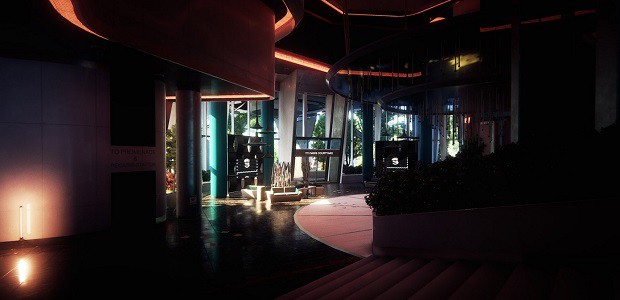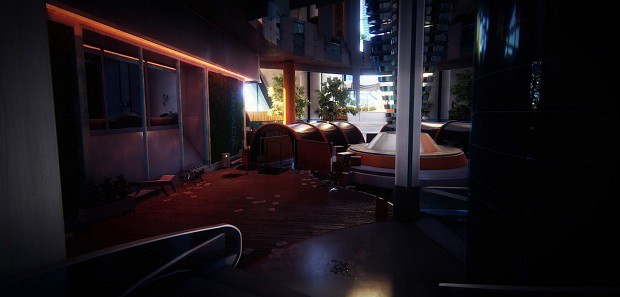System Shock Meets Open World Survival: P.A.M.E.L.A.
Shockingly good
P.A.M.E.L.A. [official site] was one of the most exciting games I saw at GDC last week. I watched around twenty minutes of live play, showing off the construction of a safe haven as night fell on the beautifully rendered sci-fi city in which the game's particular brand of survival horror takes place. It's an open world game, but it isn't quite like anything else in the genre. This is a claustrophobic open world and the game in question is an intelligent and bold exploration of the core concepts found in System Shock and Bioshock. Hell, if this were carrying the title System Shock 3, I'd be delighted.
Astonishingly, P.A.M.E.L.A. might actually live up to its concept. I'm automatically wary of survival games, which can quickly turn into a hunt for crafting materials and food. That hunt then becomes a loop - eat, craft, eat, craft, eat, craft, die. Fulfilling basic biological needs and finding bits and bobs to make a slightly better pair of trousers makes for constant and immediate short-term tasks, but they're not the most satisfying goals in the world. P.A.M.E.L.A. looks to avoid mindless repetition through the addition of an overarching survival goal, and that relates to the city's power systems.
The world you wake up in, from cryostasis, has gone to hell. The other inhabitants of Eden, the future-city utopia that is now your home, have been infected with something horrible. They're in constant pain and, naturally, they want to kill you. They skulk in the shadows, then lunge straight for you, clubbing at your head and scratching at your throat. A day/night cycle brings out the beauty of the place with truly spectacular dawn light flooding the rooms through gargantuan windows, and there is just enough that is recognisable (malls, kitchens, apartments) that the place doesn't seem like a confusion of shiny chrome corridors.
One of the first things you're advised to do is to set up a safe haven. Scattered around, in the places you might expect them to be rather than in bins and random cupboards, you'll find components for base-building. You can deploy these components anywhere in the world, the construction interface drawing lines between the nodes that throw up energy walls and clearly showing the range of any power sources. It took the developer who was showing the game a couple of minutes to set up a small camp at the intersection of three corridors, shimmering walls blocking access.
Those walls, made of energy as they are, drain power. That power comes from a core, salvaged from the world, and planted at the centre of the makeshift base. If it runs dry, the lights dim, the walls fade and you're exposed.
Thankfully, more power is available. Unfortunately, you'll have to reroute it from Eden's central reserves. To do so, you'll need to visit large routers in each area of the city. Once there, you can redirect power to the district tied to that router, allowing every device in the area to be recharged. The central core has unlimited energy - or at least enough to last far longer than you will - but the reserves in each district will peter out over time.
That means, as well as maintaining your biological functions by cramming food and drink into your face and sleeping from time to time, you'll need to maintain the city's functions as well. If your snazzy base saps too much power, elevators in the vicinity will start to shut down and whole areas will be plunged into darkness. Enemies are not only harder to spot at night, they become more aggressive and numerous when the sun sinks below the horizon.
The lasting impression, from the half hour I spent talking to studio director Adam Simonar and watching as he demonstrated the game, is of a take on the settings of System Shock and Bioshock that treats the player as a lucky/unlucky survivor rather than a hero. You exist in this world and, as far as I can tell, you are not there to find answers or escape, you are simply there to survive for as long as possible. You are a witness to the aftermath of catastrophe rather than a saviour.
All of that might be overly grim if the city itself weren't such a beautiful distraction. Although things have taken a distinct turn for the worse by the time the game begins, Eden was once utopian place. While P.A.M.E.L.A. might not be playing with social status in the way that Ballard's (and now Wheatley's) High-Rise does, it handles the contrast of sleek pre-collapse modernity/futurism and post-collapse horror incredibly well. Simonar's background is in architecture and there's evidence of transferable skills in the legibility of the setting and the way that different districts are displayed elegantly through vantage points. You have an idea of the shape and purpose of places to come simply by seeing them framed in windows and entryways.
The titular character, an AI caretaker that may well be the last non-hostile entity in the city, was notably absent in the portion of the game I was shown. She can provide support to the player in the form of conversation and modifications to the city that manifest as usable high-level skills. As with the power system, there's a clever touch whereby assistance can't always be relied upon - the smartly crafted inventory and status system, which takes the for of a display attached to the player character's arm, has a wifi-like symbol that tracks connectivity to P.A.M.E.L.A. at any one time. Move too far from the signal, or allow the cells that power it to die, and contact may well be lost.
Combat, in the current build at least, seems frequent enough to be an inconvenience in some cases rather than a potentially lethal threat. If you're overwhelmed, you're going to struggle, and ammunition isn't easy to come by, but solitary basic enemies can be dealt with using melee attacks easily enough. Those basic enemies don't look much changed from ordinary human beings, although they have a tendency to skulk in a way that is a tad unnerving, but there are other horrors to be discovered. As far as I know, all of the inhabitants are humans, in various stages of mutation, but that may not be the case. I'd rather not know at any rate - fear of the unknown and all that.
However frightening the unknown might be, P.A.M.E.L.A. isn't only for the bravest souls. Being attacked by the infected in the dark isn't a pleasant experience but the horror on show doesn't seem to be particularly intense or harrowing. There's tension involved in the management of resources and the need to scavenge outside your comfort zone, but the world isn't dripping in gore or host to troubling hallucinations. The balance between sci-fi and horror swings heavily toward the sci-fi when it comes to the setting, and the game's systems are more closely linked to Deus Ex and System Shock than to Silent Hill.
Until release, which will initially be in the form of a feature-complete stint in Early Access, it's impossible to say how much pull the mid- and late-game will have. The initial phase of establishing a safe haven and surviving the first couple of nights looks superb, but if the only reason to explore and scavenge is to collect improved weapons and abilities, there may not be enough of a reason to return again and again. There will be elements of a story to discover, in the form of documents left behind by the city's inhabitants, but the player character's story will be written as you play.
At the end of each story, when permadeath kicks in, you have the option to start over completely fresh, with the city reset to its original state, or to play as a newly awakened character in the same world as your previous character. The idea of stumbling across old defenses, constructed by those who have fallen victim to the city's inhabitants, is pleasantly chilling. I want to loot my own corpse.
If P.A.M.E.L.A. lives up to its promise, it might well be one of my favourite games of 2016. The claustrophobia of the setting, in comparison to most open world games, makes for a tightly structured survival game. Freedom is key, yes, the freedom to go where you want and to do as you please, but it's freedom within a carefully crafted space rather than at a random point on a giant wilderness map. It's a hugely ambitious debut, made by a small team, and before I'd spoken to Simonar and seen the game in action I thought it was attempting to be too many things: a survival game, an open world game, an RPG of sorts, a horror game.
Remarkably, all of those elements seem to be working well and, better still, to complement one another. It's a bold game and confident, and I can't wait to see more. Even if some elements don't work as well as I hope they will, I'm pleased to see another game - after SOMA - that is exploring similar territory to Bioshock but without quite as much reliance on running and gunning. More than that, it really does feel like a natural extension of the ideas in the first System Shock, providing freedom to explore and exploit the workings of a location's machinery to evade, advance and survive.








